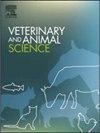Camelina straw as an eco-friendly forage alternative for finishing lambs: impacts on performance, rumen function and behavior
IF 1.9
Q2 AGRICULTURE, DAIRY & ANIMAL SCIENCE
引用次数: 0
Abstract
The increasing frequency of droughts and water scarcity has intensified interest in drought-tolerant plants and their by-products as sustainable feed alternatives for ruminants. This study assessed the partial replacement of alfalfa hay (AH) with camelina straw (CS) at 120 (CS12) and 240 (CS24) g/kg of DM in diets of Grey Shirazi lambs (n = 24, average body weight = 22.7 ± 1.7 kg). No significant differences were observed in dry matter intake (DMI), final body weight (FBW: 40.4, 38.8, 40.0 kg), average daily gain (ADG: 285, 260, 278 g/d), or feed conversion ratio (FCR: 5.2, 5.3, 5.1) across treatments. Linear reductions occurred in OM and NDFom digestibility (P < 0.05), with no effects on other nutrients. Ruminal pH, NH3![]() N, and volatile fatty acids (VFAs) profiles were not significantly altered, except for acetate and isovalerate concentrations, which increased linearly. Partial replacement of AH with CS increased ruminating and total chewing times (P < 0.01), due to higher physically effective fiber intake, without altering meal frequency or duration. These results suggest that camelina straw can be used as a partial AH substitute in lamb finishing diets up to 240 g/kg DM without compromising lamb performance, despite modest reductions in fiber digestibility and increased chewing activity. Future studies should explore behavioral and microbial ecological shifts in the rumen to better understand the mechanisms involved.
N, and volatile fatty acids (VFAs) profiles were not significantly altered, except for acetate and isovalerate concentrations, which increased linearly. Partial replacement of AH with CS increased ruminating and total chewing times (P < 0.01), due to higher physically effective fiber intake, without altering meal frequency or duration. These results suggest that camelina straw can be used as a partial AH substitute in lamb finishing diets up to 240 g/kg DM without compromising lamb performance, despite modest reductions in fiber digestibility and increased chewing activity. Future studies should explore behavioral and microbial ecological shifts in the rumen to better understand the mechanisms involved.
亚麻荠秸秆作为生态友好型育肥羔羊饲料替代品:对生产性能、瘤胃功能和行为的影响
干旱和水资源短缺日益频繁,增强了人们对耐旱植物及其副产品作为反刍动物可持续饲料替代品的兴趣。本试验对24只平均体重为22.7±1.7 kg的白拉子灰羔羊进行了饲粮中用亚麻荠秸(CS)部分替代120 (CS12)和240 (CS24) g/kg DM的苜蓿干草(AH)试验。干物质采食量(DMI)、末重(FBW分别为40.4、38.8、40.0 kg)、平均日增重(ADG分别为285、260、278 g/d)和饲料系数(FCR分别为5.2、5.3、5.1)在各处理间均无显著差异。OM和ndfo消化率呈线性降低(P < 0.05),对其他营养物质无影响。除乙酸和异戊酸浓度线性升高外,瘤胃pH、NH3N和挥发性脂肪酸(VFAs)谱无显著变化。在不改变进餐频率和持续时间的情况下,用CS部分替代AH增加了反刍和总咀嚼时间(P < 0.01),因为物理有效纤维摄入量增加了。综上所述,在饲粮中添加240 g/kg DM时,尽管纤维消化率略有降低,但咀嚼活性有所提高,但亚麻荠秸秆可部分替代亚麻酸,不会影响羔羊的生产性能。未来的研究应该探索瘤胃的行为和微生物生态变化,以更好地了解其中的机制。
本文章由计算机程序翻译,如有差异,请以英文原文为准。
求助全文
约1分钟内获得全文
求助全文
来源期刊

Veterinary and Animal Science
Veterinary-Veterinary (all)
CiteScore
3.50
自引率
0.00%
发文量
43
审稿时长
47 days
 求助内容:
求助内容: 应助结果提醒方式:
应助结果提醒方式:


